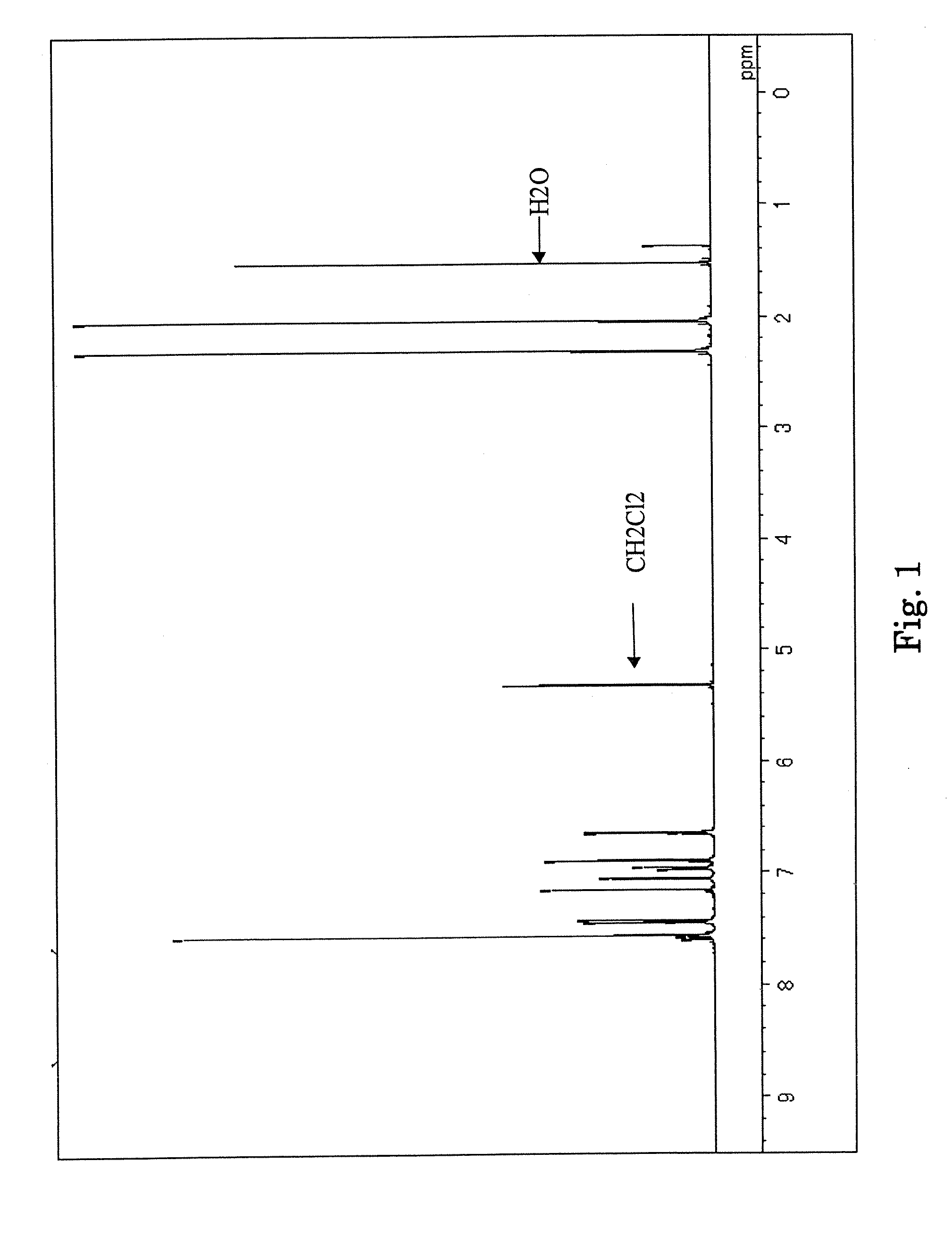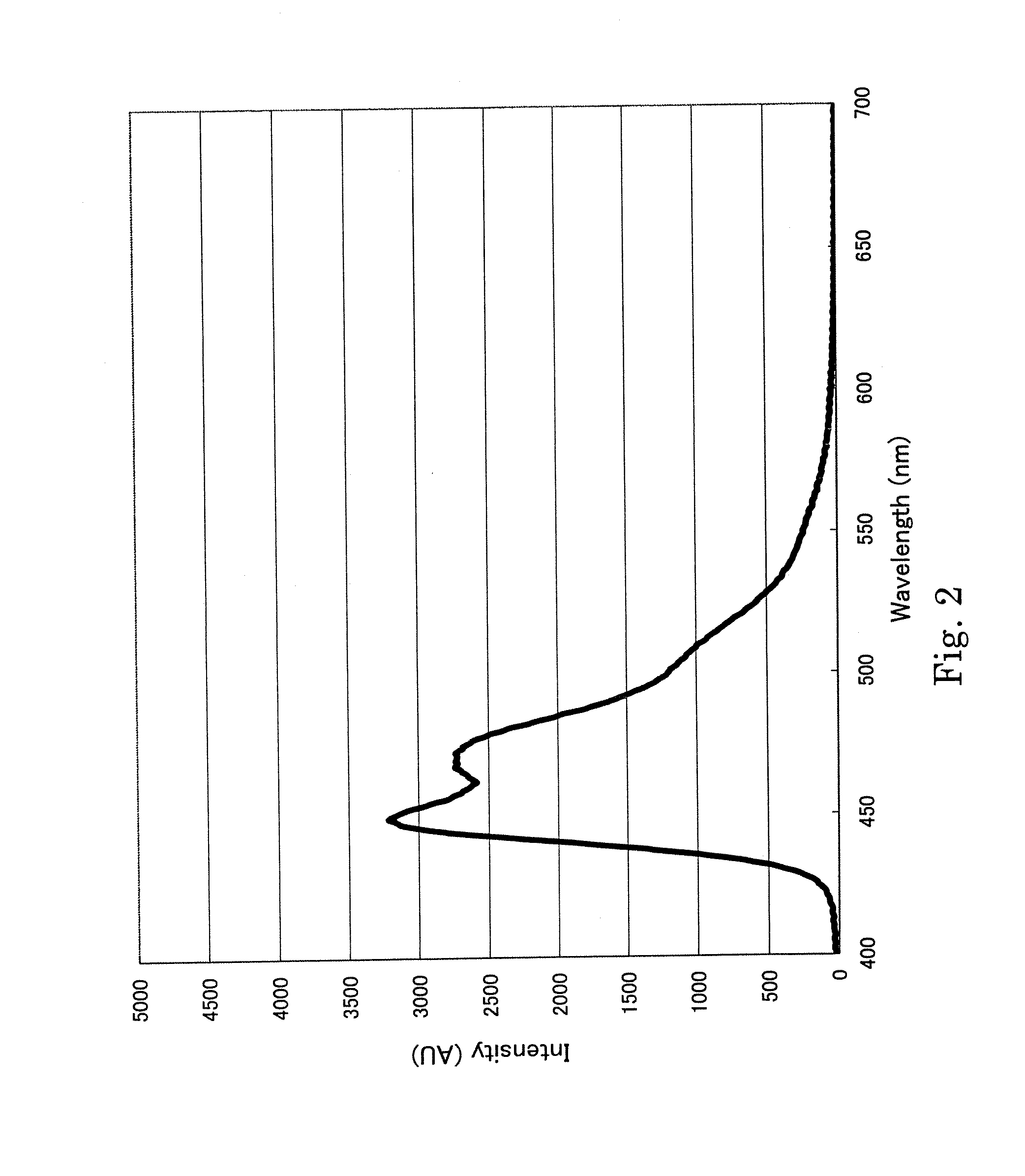Aromatic amine derivative and organic electroluminescence device using the same
an organic electroluminescence and amine technology, applied in the direction of discharge tube luminescnet screen, discharge tube/lamp details, organic chemistry, etc., can solve the problems of device deterioration, device has not been put into practical use, and provides extremely low efficiency, etc., to achieve sufficient emitted luminance for practical use, high luminous efficiency, and hardly deterioration
- Summary
- Abstract
- Description
- Claims
- Application Information
AI Technical Summary
Benefits of technology
Problems solved by technology
Method used
Image
Examples
examples
Synthesis Example 1 (D-2-2)
(1-1) Synthesis of 1,2-bis(4-bromo)ethene
[0196] In a stream of argon, 61.6 g (0.2 mol) of 4-bromo-benzylphosphonic acid diethyl ester, 37 g (0.2 mol) of 4-bromobenzaldehyde, 23.5 g (0.21 mol) of t-butoxypotassium, and 500 mL of THF were added to a 1-L three-necked flask provided with a cooling pipe, and the whole was stirred at room temperature for 8 hours. After the completion of the reaction, 500 mL of water were charged into the resultant, and the precipitated crystal was taken by filtration and washed with 500 mL of hexane, whereby 64 g of a white powder were obtained (in 95% yield).
(1-2) Synthesis of 1,2-bis(4-(4′-chlorophenyl)phenyl)ethene
[0197] In a stream of argon, 15 g (44.7 mmol) of 1,2-bis(4-bromo)ethene, 16.7 g (107 mmol) of 4-chlorophenylboronic acid, 2 g (1.8 mmol) of tetrakistriphenylphosphinepalladium, a 2-M solution prepared by dissolving 21.3 g (201 mmol) of sodium carbonate in 100 mL of water, and 100 mL of dimethoxyethane were added...
synthesis example 4d-2-6
[0201] In a stream of argon, 4 g (10 mmol) of 1,2-bis(4-(4′-chlorophenyl)phenyl)ethene, 7.8 g (25 mmol) of bis(4-trimethylphenyl)amine, 0.03 g (1.5 mol %) of palladiumacetate, 0.06 g (3 mol %) of tri-t-butylphosphine, 2.4 g (25 mmol) of t-butoxysodium, and 100 mL of dry toluene were added to a 300-mL three-necked flask provided with a cooling pipe, and then the whole was stirred under heat at 100° C. overnight. After the completion of the reaction, the precipitated crystal was taken by filtration, and was washed with 50 mL of toluene and 100 mL of methanol, whereby 7.6 g of a pale yellow powder were obtained. The powder was identified as Compound (D-2-6) (in 80% yield) by 1H-NMR spectroscopy and FD-MS. The maximum absorption wavelength and maximum fluorescence wavelength of the resultant compound measured in a toluene solution were 381 nm and 439 nm, respectively.
synthesis example 5d-2-8
[0202] In a stream of argon, 4 g (10 mmol) of 1,2-bis(4-(4′-chlorophenyl)phenyl)ethene, 6.3 g (25 mmol) of 4-cyclohexyl diphenylamine, 0.03 g (1.5 mol %) of palladium acetate, 0.06 g (3 mol %) of tri-t-butylphosphine, 2.4 g (25 mmol) of t-butoxy sodium, and 100 mL of dry toluene were added to a 300-mL three-necked flask provided with a cooling pipe, and then the whole was stirred under heat at 100° C. overnight. After the completion of the reaction, the precipitated crystal was taken by filtration, and was washed with 50 mL of toluene and 100 mL of methanol, whereby 7.7 g of a pale yellow powder were obtained. The powder was identified as Compound (D-2-8) (in 93% yield) by 1H-NMR spectroscopy and FD-MS. The maximum absorption wavelength and maximum fluorescence wavelength of the resultant compound measured in a toluene solution were 384 nm and 443 nm, respectively.
PUM
| Property | Measurement | Unit |
|---|---|---|
| current density | aaaaa | aaaaa |
| luminance | aaaaa | aaaaa |
| work function | aaaaa | aaaaa |
Abstract
Description
Claims
Application Information
 Login to View More
Login to View More - R&D
- Intellectual Property
- Life Sciences
- Materials
- Tech Scout
- Unparalleled Data Quality
- Higher Quality Content
- 60% Fewer Hallucinations
Browse by: Latest US Patents, China's latest patents, Technical Efficacy Thesaurus, Application Domain, Technology Topic, Popular Technical Reports.
© 2025 PatSnap. All rights reserved.Legal|Privacy policy|Modern Slavery Act Transparency Statement|Sitemap|About US| Contact US: help@patsnap.com



